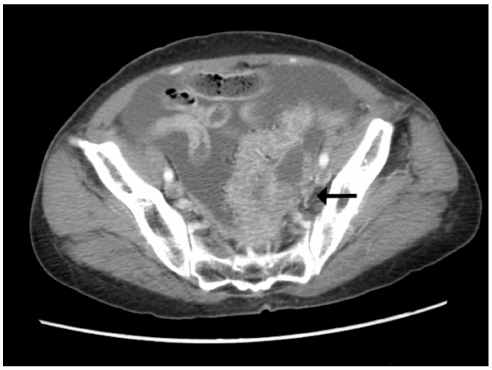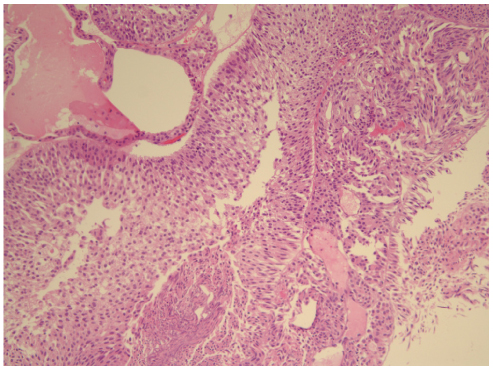Korean J Obstet Gynecol.
2012 Dec;55(12):1026-1030. 10.5468/KJOG.2012.55.12.1026.
A case of multiple primary malignancies following radiotherapy for adenosquamous cell carcinoma of the cervix
- Affiliations
-
- 1Department of Obstetrics and Gynecology, Dankook University College of Medicine, Cheonan, Korea. soo8541@hanmail.net
- KMID: 2274219
- DOI: http://doi.org/10.5468/KJOG.2012.55.12.1026
Abstract
- Given the extended survival of patients diagnosed with cervical cancer, a large number of women are treated with radiotherapy. A second primary cancer has currently become one of the most important radiation-induced injuries as the number of cancer patients who are cured is increasing by virtue of recent advancements in therapeutic radiology. A 56-year-old woman developed two pelvic malignancies 14 years after undergoing surgery and radiotherapy for adenosquamous cell carcinoma of the cervix. Previous exposure to radiotherapy is associated with certain malignancies, and review of the literature indicates that there is strong evidence to support such an association with bladder and ovarian cancer. This is the first reported case of second multiple primary malignancies (ovarian cancer and bladder cancer) after radiation therapy for adenosquamous cell carcinoma of the cervix.
MeSH Terms
Figure
Reference
-
1. Takeda T, Sagae S, Koizumi M, Terasawa K, Ishioka S, Takashima S, et al. Multiple primary malignancies in patients with gynecologic cancer. Int J Gynecol Cancer. 1995. 5:34–39.2. Benedet JL, Odicino F, Maisonneuve P, Beller U, Creasman WT, Heintz AP, et al. Carcinoma of the cervix uteri. Int J Gynaecol Obstet. 2003. 83:Suppl 1. 41–78.3. Barillot I, Horiot JC, Pigneux J, Schraub S, Pourquier H, Daly N, et al. Carcinoma of the intact uterine cervix treated with radiotherapy alone: a French cooperative study: update and multivariate analysis of prognostics factors. Int J Radiat Oncol Biol Phys. 1997. 38:969–978.4. Billroth T. Die allgemeine chirurgische pathologie und therapie. 1889. Berlin: G. Reimer.5. Werthamer S, Jabush M, Schulman J. Multiple primary malignancies. JAMA. 1961. 175:558–562.6. Matlock DL, Salem FA, Charles EH, Savage EW. Synchronous multiple primary neoplasms of the upper female genital tract. Gynecol Oncol. 1982. 13:271–277.7. Moertel CG, Dockerty MB, Baggenstoss AH. Multiple primary malignant neoplasms. II. Tumors of different tissues or organs. Cancer. 1961. 14:231–237.8. Stovall M, Smith SA, Rosenstein M. Tissue doses from radiotherapy of cancer of the uterine cervix. Med Phys. 1989. 16:726–733.9. Boice JD Jr, Engholm G, Kleinerman RA, Blettner M, Stovall M, Lisco H, et al. Radiation dose and second cancer risk in patients treated for cancer of the cervix. Radiat Res. 1988. 116:3–55.10. Boice JD Jr, Day NE, Andersen A, Brinton LA, Brown R, Choi NW, et al. Second cancers following radiation treatment for cervical cancer. An international collaboration among cancer registries. J Natl Cancer Inst. 1985. 74:955–975.11. Arai T, Nakano T, Fukuhisa K, Kasamatsu T, Tsunematsu R, Masubuchi K, et al. Second cancer after radiation therapy for cancer of the uterine cervix. Cancer. 1991. 67:398–405.12. Kleinerman RA, Boice JD Jr, Storm HH, Sparen P, Andersen A, Pukkala E, et al. Second primary cancer after treatment for cervical cancer. An international cancer registries study. Cancer. 1995. 76:442–452.13. Ohno T, Kato S, Sato S, Fukuhisa K, Nakano T, Tsujii H, et al. Long-term survival and risk of second cancers after radiotherapy for cervical cancer. Int J Radiat Oncol Biol Phys. 2007. 69:740–745.






